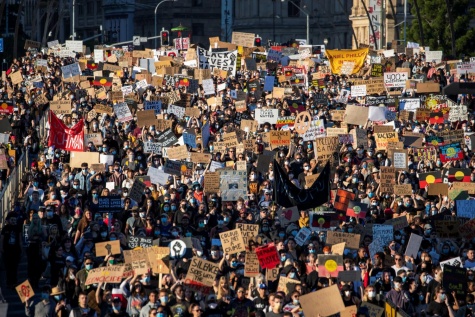
By: Lucas Rapeepat | Sports Editor & Harrison York | Head Editor
September 9, 2020
On May 25, George Floyd, a black man, was killed by a Minneapolis police officer during his arrest. Caused by asphyxiation—the officer had knelt on Floyd’s neck for nearly eight minutes—his death sparked widespread outcry across the nation, both on social media and in protests on the streets. Just hours later, the interaction drew throngs of supporters to the largest cities in America, including Los Angeles, New York, and Chicago.
Before Floyd’s death, social demonstrations and gatherings were widely denounced, prompting statements by authorities to remain indoors in order to prevent the spread of COVID-19. Colossal events, such as the Olympics and Coachella, were cancelled, and schools and small businesses had to close their doors soon after. Black Lives Matter (BLM) protests, however, provoked a far different response.
Protesters were encouraged to gather in solidarity in response to the act of racism. Despite the prior sentiment urging people to stay inside, quarantine, and venture outdoors only when necessary, local and national leaders alike voiced their support for these demonstrations and the organizations behind them.
“This is a historic moment of change. We have to respect [BLM protests] but also say to people the kinds of gatherings we’re used to, the parades, the fairs—we just can’t have that while we’re focusing on health right now,” Mayor of New York City Bill de Blasio said when speaking on his cancellation of all events besides the protests through September.
This sentiment was shared by leaders across the country, with protesters seemingly exempt from the previous restrictions on outdoor activities, let alone large gatherings.
These protests were often conducted with proper social distancing measures, including wearing masks and marching six feet apart, yet a number of them broke down into city-wide displays of destructive looting and rioting. These incidents were uncommon in the numerous peaceful protests around the nation, but where they occurred, cities were left damaged, with many small businesses razed and forced to close indefinitely. With thousands of protests, each containing many more thousands of individual protesters, did these groupings contribute to the resurgence of the virus?
“In all likelihood, some infections occurred at the protests,” Brown University epidemiology professor Mark Lurie said. “The question is how much.”
The difficulty with discerning whether infection occurred at protests or through reopening efforts, however, is that these two factors happened simultaneously. By mid-late June, it was apparent that the amount of new cases per day was surging nationwide. The cases-per-day passed previous highs and peaked in July at about 75,000 cases on the 17th, according to Google. While many businesses that had recently reopened, which were following health regulations, now had to return to their previous, closed state, the support the protests received from politicians, celebrities, and citizens did not waver.
“It was a thick crowd around the base of the pier, but as the protest started moving more people dissipated… For the most part everyone tried to distance,” a San Clemente High School senior said of the San Clemente BLM protest in May. “At the beginning it got hard in some places—tight streets, small sidewalks—but everyone was wearing a mask.”
Around 100 protesters were present at the local protest, and the student attended multiple protests and marches over summer, noting that there were opposing groups at the protests calling for reopening efforts.
The student also said that there “were many individuals who spoke and shared their personal experiences. It was very inspirational.” While she believes that “the outrage of the protesters is valid,” she explains that the instances of looting “can be harmful to the movement.”
Although these peaceful protests were reality for the majority of demonstrations across the nation, much different scenes played out in major cities. In Seattle, part of the city was claimed by activists as an autonomous zone. Known as CHAZ or CHOP, the crowded area lacked social distancing measures, and while many people wore masks, safety measures were limited. In Minneapolis, tens of thousands of enraged citizens flooded the city, their protests breaking down into rioting and looting at night. By June 16, 700 buildings had been burned, looted, or damaged following these violent events, according to a CBS study. In these cases where organized, non-violent protesting breaks down, is it safe to assume that proper social distancing measures remain intact? Local protests, like those in San Clemente, are able to practice proper social distancing because of smaller crowds and constructive planning.
With the massive gatherings and high-tension situations in larger cities, proper safety measures are less often observed. In these environments, people can spread germs by bumping into each other, distributing signs or other materials, or by simply not wearing a mask. Taking into account the occurrence of numerous protests in the days leading up to the spike in cases, it is unrealistic to say that the protests had no impact on spreading the coronavirus. Still, taking the data into account, the protests did not have egregious effects on COVID-19 cases, and although not perfect, organizational efforts helped keep the spread to a minimum.

Leave a Reply